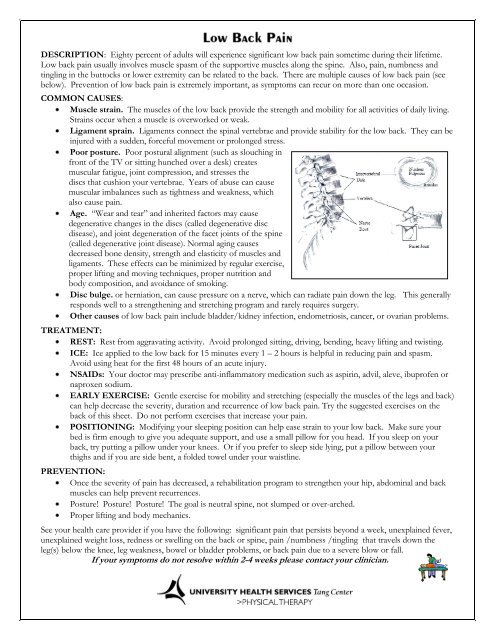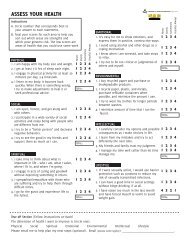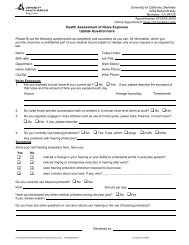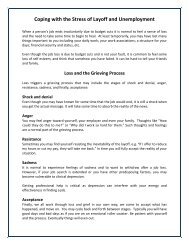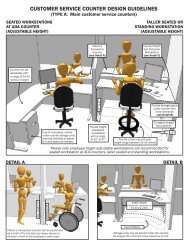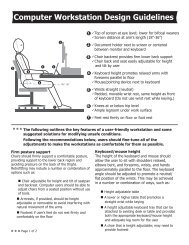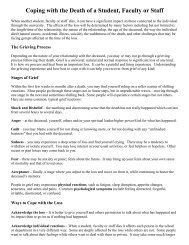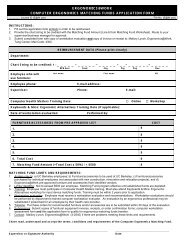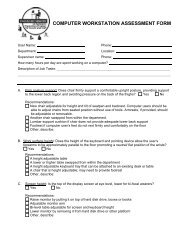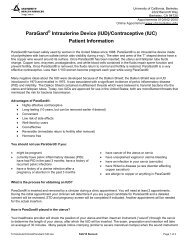Low Back Pain (pdf)
Low Back Pain (pdf)
Low Back Pain (pdf)
Create successful ePaper yourself
Turn your PDF publications into a flip-book with our unique Google optimized e-Paper software.
DESCRIPTION: Eighty percent of adults will experience significant low back pain sometime during their lifetime.<br />
<strong>Low</strong> back pain usually involves muscle spasm of the supportive muscles along the spine. Also, pain, numbness and<br />
tingling in the buttocks or lower extremity can be related to the back. There are multiple causes of low back pain (see<br />
below). Prevention of low back pain is extremely important, as symptoms can recur on more than one occasion.<br />
COMMON CAUSES:<br />
Muscle strain. The muscles of the low back provide the strength and mobility for all activities of daily living.<br />
Strains occur when a muscle is overworked or weak.<br />
Ligament sprain. Ligaments connect the spinal vertebrae and provide stability for the low back. They can be<br />
injured with a sudden, forceful movement or prolonged stress.<br />
Poor posture. Poor postural alignment (such as slouching in<br />
front of the TV or sitting hunched over a desk) creates<br />
muscular fatigue, joint compression, and stresses the<br />
discs that cushion your vertebrae. Years of abuse can cause<br />
muscular imbalances such as tightness and weakness, which<br />
also cause pain.<br />
Age. “Wear and tear” and inherited factors may cause<br />
degenerative changes in the discs (called degenerative disc<br />
disease), and joint degeneration of the facet joints of the spine<br />
(called degenerative joint disease). Normal aging causes<br />
decreased bone density, strength and elasticity of muscles and<br />
ligaments. These effects can be minimized by regular exercise,<br />
proper lifting and moving techniques, proper nutrition and<br />
body composition, and avoidance of smoking.<br />
Disc bulge. or herniation, can cause pressure on a nerve, which can radiate pain down the leg. This generally<br />
responds well to a strengthening and stretching program and rarely requires surgery.<br />
Other causes of low back pain include bladder/kidney infection, endometriosis, cancer, or ovarian problems.<br />
TREATMENT:<br />
REST: Rest from aggravating activity. Avoid prolonged sitting, driving, bending, heavy lifting and twisting.<br />
ICE: Ice applied to the low back for 15 minutes every 1 – 2 hours is helpful in reducing pain and spasm.<br />
Avoid using heat for the first 48 hours of an acute injury.<br />
NSAIDs: Your doctor may prescribe anti-inflammatory medication such as aspirin, advil, aleve, ibuprofen or<br />
naproxen sodium.<br />
EARLY EXERCISE: Gentle exercise for mobility and stretching (especially the muscles of the legs and back)<br />
can help decrease the severity, duration and recurrence of low back pain. Try the suggested exercises on the<br />
back of this sheet. Do not perform exercises that increase your pain.<br />
POSITIONING: Modifying your sleeping position can help ease strain to your low back. Make sure your<br />
bed is firm enough to give you adequate support, and use a small pillow for you head. If you sleep on your<br />
back, try putting a pillow under your knees. Or if you prefer to sleep side lying, put a pillow between your<br />
thighs and if you are side bent, a folded towel under your waistline.<br />
PREVENTION:<br />
Once the severity of pain has decreased, a rehabilitation program to strengthen your hip, abdominal and back<br />
muscles can help prevent recurrences.<br />
Posture! Posture! Posture! The goal is neutral spine, not slumped or over-arched.<br />
Proper lifting and body mechanics.<br />
See your health care provider if you have the following: significant pain that persists beyond a week, unexplained fever,<br />
unexplained weight loss, redness or swelling on the back or spine, pain /numbness /tingling that travels down the<br />
leg(s) below the knee, leg weakness, bowel or bladder problems, or back pain due to a severe blow or fall.<br />
If your symptoms do not resolve within 2-4 weeks please contact your clinician.
BASIC EXERCISES FOR THE LOW BACK<br />
Perform these exercises slowly, without forcing movement. Be sure to breathe throughout the exercises. You should<br />
feel a slight stretch, however, do not move into pain. Your symptoms should not intensify as a result of doing your<br />
exercises. Perform the exercises 2-3 times daily.<br />
Hip Flexors(fig.5)<br />
Hamstrings (fig.1)<br />
stretch front<br />
↓ of hip<br />
Lying on floor, pull thigh towards your chest to about 90 .<br />
Straighten your knee until a stretch is felt in back of thigh.<br />
Hold 1 minute. Repeat with opposite leg.<br />
Single Knee to Chest (fig.2)<br />
Lying on you back, pull one knee to the chest to keep the<br />
back flat. Allow the opposite thigh to drop over the edge of<br />
the bed. Do not allow the thigh to move away from the<br />
midline or rotate. Hold 30 seconds. Repeat 2 times each leg.<br />
Prop Up on Elbows (fig.6)<br />
Pull knee in to chest until a comfortable stretch is felt in hip<br />
and lower back. Hold 15 seconds. Repeat with opposite leg.<br />
Repeat 5-10 times each leg.<br />
Pelvic Tilt (fig.3)<br />
On firm surface, lying on your stomach, prop up on your<br />
elbows. Keep pelvis, hips and legs relaxed. If propping on<br />
elbows is painful, try only lying on stomach or with a pillow<br />
under your abdomen. Hold 30 seconds. Repeat 3-5 times.<br />
Tail Wag (fig.7)<br />
Flatten back by tightening stomach and buttock muscles.<br />
Hold 10 seconds. Repeat 10 times.<br />
Cat and Camel (fig.4)<br />
On all fours with back maintained in neutral position, gently<br />
move hips toward rib cage to side bend trunk. Hold briefly,<br />
then alternate and do other side. Repeat 10-15 times.<br />
Lumbar Rotation (fig.8)<br />
On all fours, assume a “hump” back position by arching the<br />
back up. Hold briefly and then slowly lower the back into a<br />
sagging position. Repeat 10-15 times.<br />
Slowly rock knees from side to side in a pain free range of<br />
motion. Allow back to rotate slightly. Repeat 10-15 times.<br />
Rev 9/11


